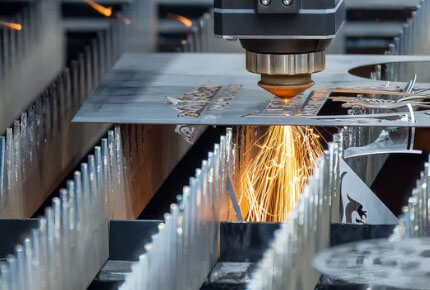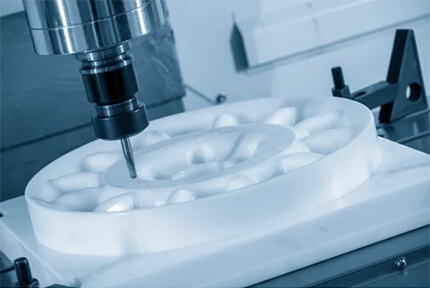Alongside 3D printing, CNC machining stands as a leading manufacturing technology for rapid prototyping. In this blog, we explore CNC machining basics and 5 key benefits of CNC rapid prototyping.
Quick View
- How does CNC work for rapid prototyping?
- The CNC prototype-making speed is very fast.
- Design testing and iteration with CNC are quicker.
- CNC rapid prototyping saves costs during product development.
- CNC prototypes are guaranteed with high precision and accuracy.
- CNC can process a wide range of materials to make prototypes.
How does CNC machining work for rapid prototyping?
CNC (Computer Numerical Control) machining is a popular method for rapid prototyping. It can quickly produce complex parts and products with high precision and accuracy, followed by sample testing and adjustments before going to massive production.
Here are 5 steps to how CNC machining produces a quick prototype, with an example of the custom-designed ring that has intricate filigree details.
1. Design
Use computer-aided design (CAD) software to create a 3D CAD model of the ring design.
2. Programming
Program the CNC machine using computer-aided manufacturing (CAM) software. The CAM software translates the design into a set of instructions that the CNC machine can understand.
3. Select material
Choose appropriate materials according to your product requirement and budget. Suppose the chosen material is silver.
4. Create the prototype
The CNC machine cuts and shapes the ring from a block of silver. Tiny cutting tools are used to create delicate filigree details, which would be difficult to achieve using traditional jewelry-making methods.

5. Finishing
After the machining process is complete, the ring may require additional finishing processes, such as polishing, cleaning, or plating.
This is a video helping you comprehend the process of ring-making using CNC machines in a more intuitive manner.
CNC rapid prototyping is fast.
Upon successful programming, a good CNC machine can transform a raw metal block into a completed component within a matter of minutes. This applies to simple, straightforward parts. Components with elaborate shapes and details may necessitate hours. And compared to harder materials (e.g. stainless steel), softer materials (e.g. aluminum) can be machined more quickly.
While this usually takes several days (sometimes weeks) under traditional manufacturing techniques such as injection molding and die casting.
CNC prototyping allows for rapid design adjustments and iterations.
This facilitates swift design modifications and product prototype iterations. You can identify any design flaws and correct them early in the product development process.
For example, you utilize CNC machining to create a pendant prototype with custom, complicated geometric patterns. After assessing the design, size, and overall aesthetic appeal, you decide to refine the pattern and resize it for better wearability. For these changes, it’s easy to modify the CAD model design and then create the iterated prototype quickly.
- A Small Summary
All these greatly reduce total product development lead time. This can help you take new products to the market more rapidly and maintain a competitive edge.
CNC rapid prototyping can save costs.
CNC machining eliminates the need for distinct or additional tools when making prototypes. This means you don’t need to invest in expensive tooling or molds at the very beginning.
For soft materials such as foam and plastic, the cost is only tens of dollars. When it comes to metal and ceramics, which are harder, the cost will be hundreds of dollars. Compared to injection molded prototypes, this is much more cost-effective.
Besides that, the automated CNC machining process can reduce the need for manual labor and associated costs.
In this way, you are able to allocate resources to other crucial aspects of product development, including prototype evaluation and quality assurance.
CNC rapid prototyping advantages production precision and accuracy.
The standard CNC machining tolerance limit is set around ± 0.125 mm. For reference, the thickness of human hair is 0.05 mm. This ensures superior levels of accuracy and precision, in comparison to traditional manufacturing methods. Ideal for accurately producing prototypes with complex geometries and fine features, for example, jewelry and watches with unique engravings and intricate details.
Tighter tolerances can also be achieved by operating specialized cutting tools under controlled conditions, for the purposes of more stringent aerospace and automotive parts.
CNC rapid prototyping works with a variety of materials.
CNC machining can work with a variety of materials, including metals like gold, silver, and platinum, as well as non-metallic materials like wood, plastic, glass, foam, acrylic, wax, etc. This can assist in product development.
For one custom design, like jewelry, you can experiment with different materials (e.g. aluminum, or stainless steel) and finish to achieve the desired look and feel for your prototypes. Just simply making minor modifications to the cutting tool’s speed and feed can make it.



In conclusion, CNC accelerates the prototyping process and reduces product development time. CNC prototyping is ideal for quick, precise, and versatile material prototypes. However, for affordable prototyping with thermoplastics, 3D printing is a suitable alternative.
We are Jingsourcing, a leading sourcing company in China. So far, we’ve helped 4000+ clients worldwide to customize products, from design, rapid prototyping using 3D printing & CNC, and sample modification, to bulk production after final sample confirmation, product inspection, and cargo transportation.

Leave A Comment